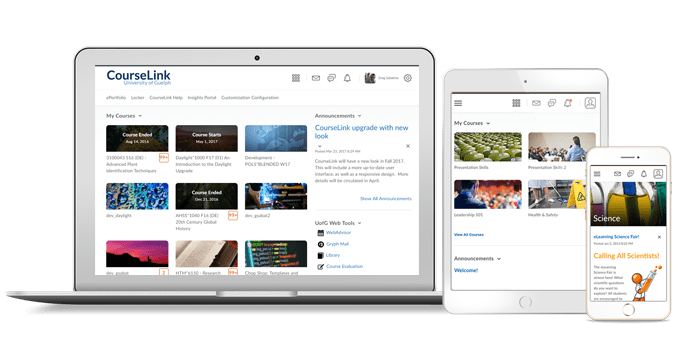
Students and Instructors
Brightspace Editor – Replaces the HTML Editor
This feature releases the new and improved Brightspace Editor.
Please note this feature will be turned on starting April 29, 2021. Please note that this editor has a bug and will be delayed until the May 2021 updates.
The new Brightspace Editor permanently replaces the previous editor in the new Dropbox Evaluation Experience and the new Dropbox Creation Experience. The new Brightspace Editor will be the only editor available in all new experiences released from April 2021 onwards. The new Editor will be released in the following tools at a later date:
- Quiz Builder
- Activity Feed
- New Rubrics
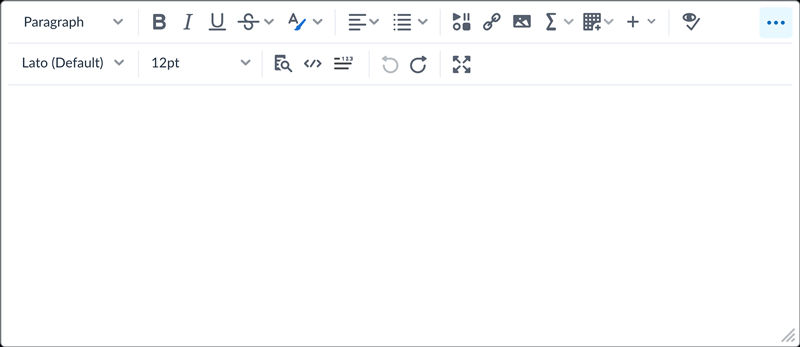
The new Brightspace Editor includes the following improvements to existing features:
- Refreshed formatting options
- The Lato font type
- A refreshed color picker
- A refreshed font size menu
- A comprehensive and standard emoticon menu
- A comprehensive and refreshed Symbols menu
- An advanced source code editor
- A refreshed Tables feature, including data sorting
- A refreshed Accessibility Checker
- The Check Accessibility, HTML Source Editor, Preview, and Toggle Full Screen functionalities have now been placed in the top bar
The Editor also includes the following new features:
- Wordcount functionality that includes words, characters, and text selection.
- Context menus while editing to enable quick access to text, link, and image editing options; including advanced image editing options. Note that image editing is not available in all context menus yet.
- A new overflow menu with additional, less frequently used menu options.
The list below outlines what is not included in the Editor:
- Spell check functionality. D2L recommends using your browser spell check functionality.
- Cut/Paste functionality. D2L recommends using your browser hot keys/menus for this functionality.
Rubrics – Navigation Accessibility Improvements
This feature was originally released for the Rubrics tool in June 2020 and updated in July 2020 and March 2021. To increase the value of the rubric tool in CourseLink, there have been accessibility improvements to the rubric creation and evaluation workflows:
- Screen readers now inform users of controls for adding feedback to criteria when reading the criteria group table. The table summary now includes the following text: This table lists criteria and criteria group names in the first column. The first-row lists level names and includes scores if the rubric uses a numeric scoring method. You can give feedback on each criterion by tabbing to the add feedback buttons in the table.
- When a score field has the focus, the screen reader now informs the user if it is a criterion score or a total score based on the field label. It also indicates which criterion the score is associated with and what action the user can take. For example: 2/4, score of Criterion 1. Press Enter to override the criterion score.
- Previously, the Total Score and Criterion Score fields did not clearly indicate whether the score is a manual override. The override information appeared in a tooltip that was not visible to assistive technology including screen readers; an asterisk was the only differentiator. Now, the screen reader can read the tooltip content when the Total Score or Criterion Score fields have the focus.
- Previously, when the Total Score was a manual override, the Clear Override button appeared; however, when Criterion Score was a manual override, the Clear Override button only appeared if the focus was on the score. Now, Clear Override appears when either the Total Score or the Criterion Score is a manual override, regardless of where the focus is.
- To improve usability with assistive technology, the Add Feedback button indicates to screen readers the criterion to which the feedback is associated. The Clear Feedback button also indicates the associated criterion.
- When the keyboard focus moves to the default rubric group or new criteria group, the screen reader now tells users the number of rubric levels and criteria in the group.
- Previously, users who used keyboard-only navigation and screen readers were not able to delete aligned outcomes. Now, when a user navigates to the Browse Standards button and focuses on an outcome tag, the screen reader reads the tag content and provides guidance that they can press Delete to remove the aligned outcome
- Previously, the screen reader only read the content of the level name and points fields and indicated that it was a text field. There was no indication of the significance of the field. Now, when the level name text field has the focus, screen readers indicate that the field is for editing the name of a specific level. When the points text field has the focus, the screen reader indicates that the field is for editing the points of a specific level.
Instructor Only
Dropbox – Action menu for group assignments in New Dropbox Evaluation Experience
The New Dropbox Evaluation Experience now includes a drop-down menu from the group name. This menu contains links to:
- Email the group (opens in a new window)
- See all group members
- Instant message the group (opens in a new window)
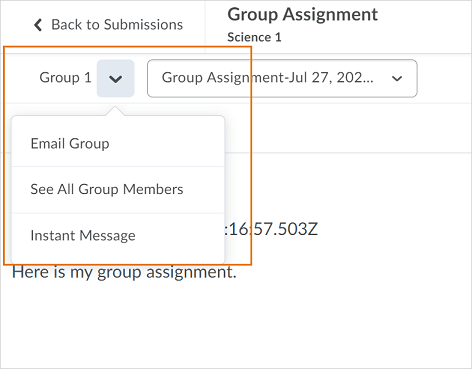
Dropbox – Anonymous marking in the New Dropbox Evaluation Experience
This feature makes anonymous marking fully supported in the New Dropbox Evaluation Experience. When using Anonymous marking, the Anonymous User number appears in place of the username, just as it appeared in the legacy Dropbox experience. In addition, the following features of anonymous marking remain the same:
- No profile card appears for anonymous users
- Usernames become visible once any learner’s evaluation is published
- Group names are always visible even when using anonymous marking
- Rubrics do not include the user’s name
Anonymous marking uses Publish All instead of the Publish button. If no feedback for anonymous users has yet been published, the Publish button is disabled and a message appears to direct users to the Publish All button. If any user feedback has been published, all Publish buttons become automatically enabled.
![Anonymous marking in Dropbox displays learners as Anonymous User [#] instead of by username.](https://bpb-ca-c1.wpmucdn.com/wp.opened.uoguelph.ca/dist/2/436/files/2021/04/dropbox_anonymous.png)
Dropbox – Context menu on the Evaluation screen in the New Dropbox Evaluation Experience
A new context menu appears in the side panel of the updated Dropbox evaluation screen. This menu links to the following:
- Edit Activity (opens assignment page in new tab).
- Special Access Dates (opens the Edit Activity screen so users can update Special Access rules).
Note: The context menu will not appear if the user does not have the required permissions to access these links.
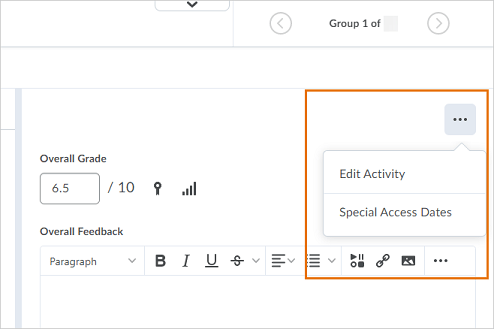
Dropbox- Single file submissions open directly in the New Dropbox Evaluation Experience
In the New Dropbox Evaluation Experience, when a learner has submitted only one file, the evaluator no longer has to click into the evaluation and then into the file. The file opens directly for the evaluator, saving a click during the evaluation process. Late submission information continues to display above the file, as it currently does.
Brightspace Insights – Engagement Dashboard User Level Metrics
To increase the value of the new Engagement Dashboard, originally released in November 2020 and most recently updated in March 2021, this release adds the following:
- New User Level Metrics tab in Engagement Dashboard Settings where you can select which metrics appear on the Learner Engagement Dashboard display.
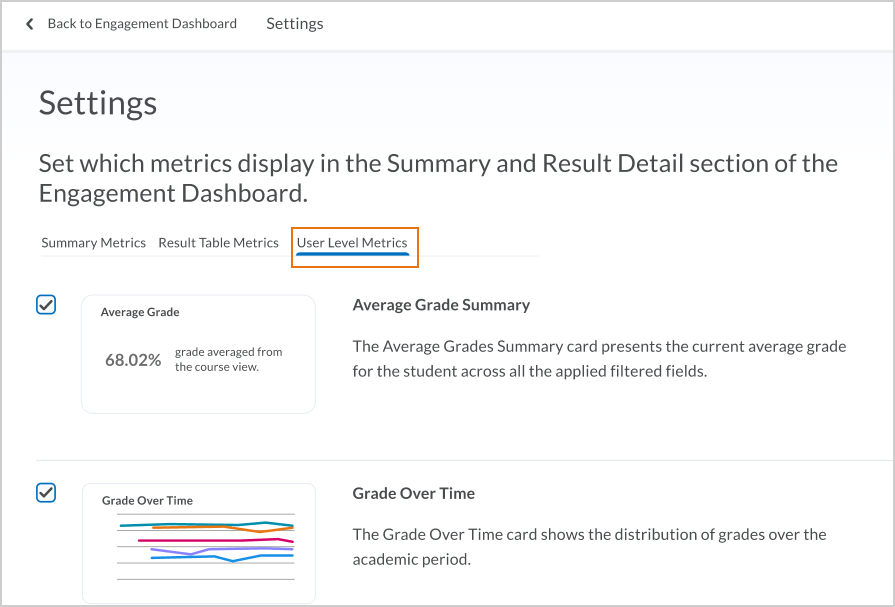
Classlist – Search filter when adding existing users
When enrolling users in a course, an instructor can now deselect the Include users already enrolled in org unit check box to set their search filter to filter out users already enrolled in the course.
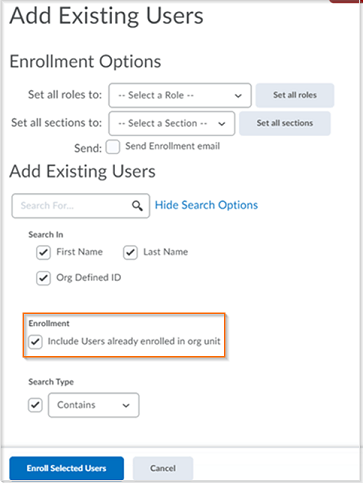
Content – URL topics now Open as External Resource by default
Previously, when a user created a new URL Content type, the Open as External Resource option was not selected by default. In some cases, this caused a Cross-Origin resource sharing (CORS) error to appear when viewing the content topics. Now, the URL Content type, such as a Google Team Drive Public link, has the Open as External Resource check box selected by default. Users can choose to deliberately remove the Open as External Resource option if necessary. If it is deselected, users are advised that D2L recommends opening links in a new window to prevent issues viewing the resource before saving.
When viewing a content topic that is a URL, the button to open the resource in a new window always appears so that if the content cannot load in an embedded frame, a user can choose to open the content in a new window.
Grades – Mastery View calculation improvements
Mastery View was originally released for the Grades tool in December 2020. To increase the value of the Mastery View of the Grades tool in CourseLink, there have been improvements to the calculation functionality:
- When you switch to a calculation method, but do not save the new method, you can return to the original calculation method, and restore the original values of the Choose Activities to use in the calculation field. If you switch to a new calculation method and save the new method, if you return to the original calculation method, the Choose Activities to use in the Calculation field uses the default values.
Quizzes – Improvements to Special Access functionality
Instructors can now grant learners special access in terms of quiz time multipliers (for example, 1.5x quiz time) or +minutes (for example, an additional 30 minutes). For example, if an instructor has a 30-minute quiz and using the Special Access page, grants three learners 1.5x the quiz time, their updated quiz time of 45 minutes displays. Instructors no longer have to manually calculate the updated quiz time.
Note: After extending the learners quiz time by way of quiz time multipliers or +minutes on the Special Access page, if an instructor updates the duration of the quiz, the learner’s quiz time on the Special Access page does not dynamically update at this time.

Quizzes – Secure and consistent editing experience
For a more secure and consistent editing experience in CourseLink, creating any of the following question types now automatically filters out JavaScript and non-standard HTML: Likert, Ordering, Matching, Fill in the Blanks, Short Answer, Multi-Short Answer, Arithmetic, and Significant Figures. For existing questions containing JavaScript and non-standard HTML, the questions continue to display as intended until an instructor edits and saves the questions, which removes the JavaScript and non-standard HTML. Previously, instructors could add JavaScript or non-standard HTML to question types in order to create dynamic content for quizzes.
Contact
If you have any questions about the updates, please contact CourseLink Support at:
courselink@uoguelph.ca
519-824-4120 ext. 56939